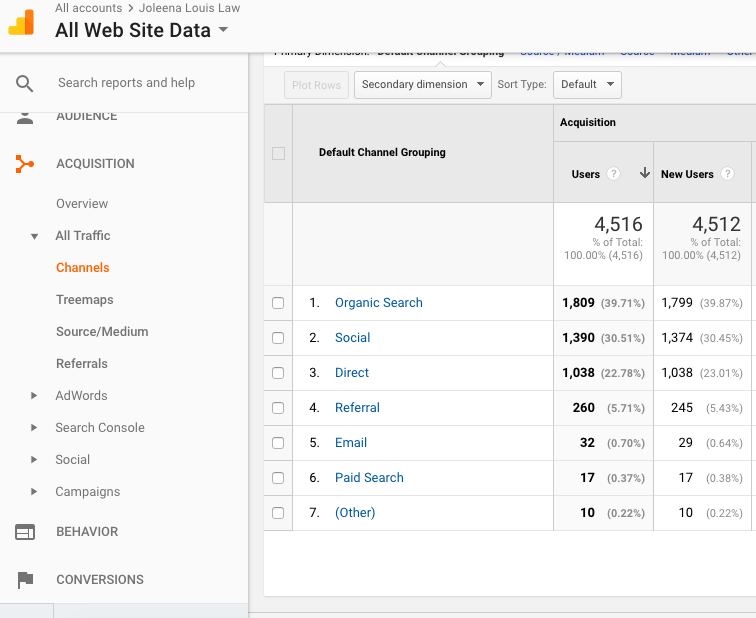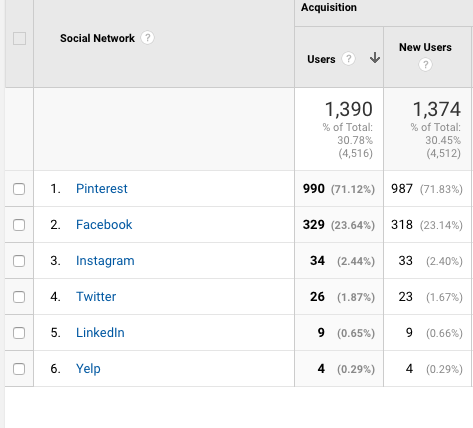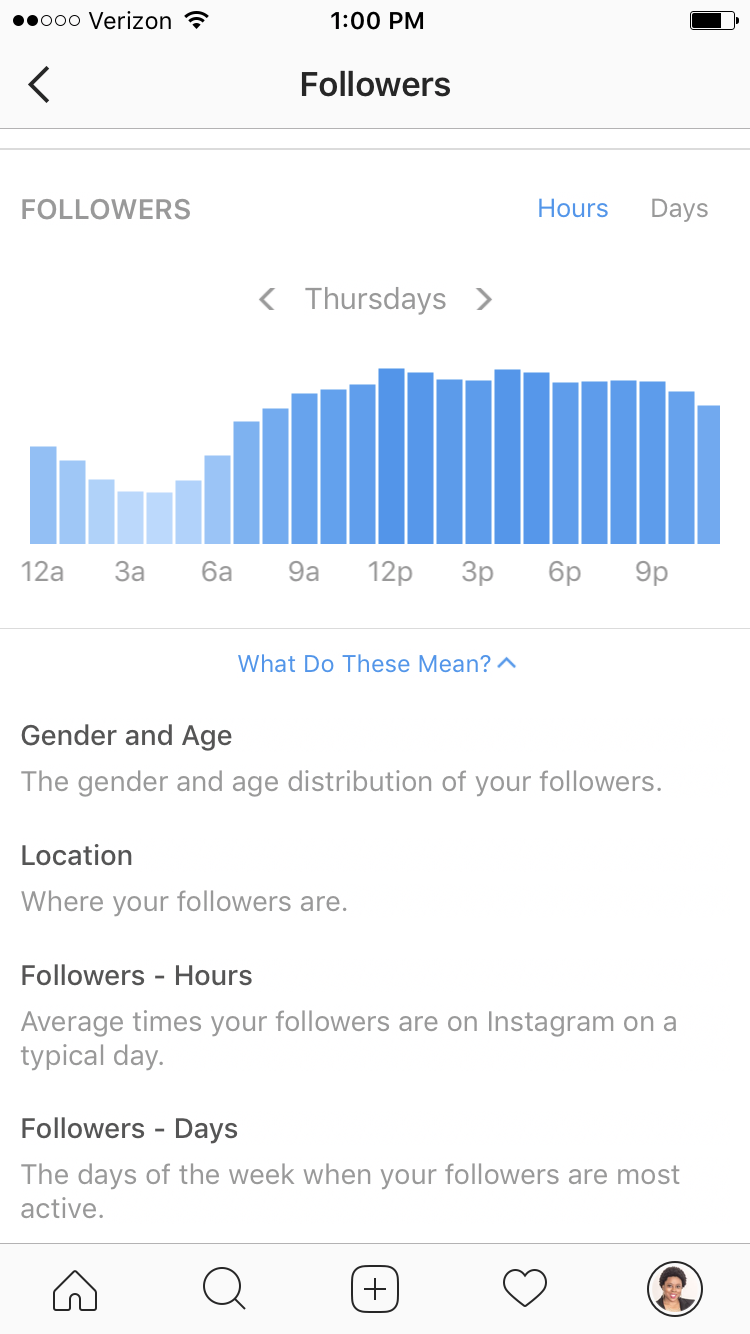How To Use Analytics To Get The Most Out Of Your Law Firm Marketing
One of the primary ways I have maximized the results of my law firm marketing is to track and review analytics.
Analytics are the systematic analysis of data and statistics. There is data to be collected everywhere in your law practice, from how long it takes to complete an average case to what types of content bring in paid content. Collecting and analyzing data has helped me determine how to set my flat fees and allows me to accurately predict my income for the year.
If you want to strategically grow your practice, analytics is a must.
Here are some great ways to use analytics to get the most out of your marketing:
GOOGLE ANALYTICS
How to Use Google Analytics to Help Improve Your Marketing Strategy
What Is Google Analytics?
Google Analytics is a FREE tool that tracks and analyzes traffic to your website. Sounds pretty simple, but it can actually provide you with a ton of useful information to help you increase traffic and reach your target audience.
What Data Can You Gather?
Audience Demographics
Understanding exactly who you are marketing to is the foundation of any marketing strategy. So learning who is visiting your site in terms of their age, location, and gender is the most effective way to tailor your site to attract that audience.
To find this information, click on the Audience tab. I focus on the demographic section. For my site, the majority of my audience is 25-34 and a little over half are male. This aligns with my target audience and I know I need to create content that appeals to this demographic.
I also like to look at Geo. I am a New York attorney so it is important that I am targeting people in NY. Keeping an eye on this data helps me ensure that the SEO for my site is leading clients in my jurisdiction to me. The majority of my visitors are located in NY, so I know I am on the right track.
Traffic Channels
One of the most useful data categories in Google Analytics is traffic channels. This shows you exactly where your traffic is coming from. This can help you determine exactly where to focus your efforts.
To see your traffic sources, go to the “Acquisition” tab then click the “All Traffic” from the drop-down menu. From there click “Channels.” Once on the page, you can choose the timeframe you want to view.
The various channels include:
-
Direct: These are visitors that came directly to your website. By typing your URL into their browser or clicking on a link in an email. These may be people who have your business card or were forwarded a link to your website.
-
Referral: Visitors that clicked a link on another site to get to your website are referrals. You can build up your referrals by guest blogging or getting other high-quality websites to link to yours.
-
Social: There are people who found you via social media. This is super useful for determining which social media sites are working for you and can help guide your social media strategy. For Joleena Louis Law, I get most of my traffic from Pinterest, Facebook, and Instagram.
-
Organic Search: An organic visitor is someone who got to your website by clicking on a link from a search engine. This is where keywords and SEO come into play. This also represents clients who may have googled your name or the name of your practice.
-
Paid Search: A paid search visitor usually comes from Pay Per Click ads like Google Adwords. A high amount of traffic in this category means your ads are working.
-
Email: An email visitor is someone that came to your website from an email campaign. This category can help you determine how effective your campaigns are.
My top two channels are organic search and social media, which makes sense given the amount of time and effort I put into these channels as part of my marketing efforts.
Content Drilldown
Another very important data category is content drilldown. This category shows you which pages people view and spend the most time on.
Click the Behavior tab, go to "Site Content", then click "Content Drilldown". You’ll also want to check out Landing and Exit Pages.
Learning which pages are viewed the most viewed by your audience will help guide your content strategy and help you focus on the content your audience wants. Analyzing and implementing changes with this data has helped increase my website views and directly increased the number of consultations scheduled from people who found my website through search.
SOCIAL MEDIA
How to Use Social Media Analytics to Help Improve Your Marketing Strategy
Individual Post Performance
The key here is to look for trends. Which posts are performing the best?
You can track this by looking at share count, number of likes, or using the analytics tracking for each individual social platform. For example, an Instagram business profile gives you analytics almost as good as Google Analytics. You can see which posts performed the best, demographics of your audience, and even the best time to post.
You can use this data to post the most engaging content at the optimal time.
Channel Performance
You can also use analytics to analyze your overall channel performance. If you are not getting great engagement, despite your best efforts, maybe your audience is not on this platform.
How many people are looking at your page, engaging with your posts, and clicking? Are you getting conversions?
Case Analytics
How to Use Case Data to Help Improve Your Marketing Strategy
This is the case data that you should be tracking to improve your marketing strategy:
New leads by case type
If leads are not coming in for a certain type of case, you may need to adjust your marketing strategy or drop that practice area.
Conversions by case type
How many of your leads turn into paying clients? This data can be really useful in determining ROI on a particular marketing strategy.
Fees by case type
Knowing how much each type of case brings in can help you know what to focus on. I bring in larger fees with divorces than anything else, so the bulk of my marketing strategy is focused on getting divorce cases. I still market for child support, child custody, etc., but I will spend the bulk of my time, energy, and budget on divorce because it has the largest return on investment.
PUTTING ANALYTICS INTO ACTION
Focus on measurements that matter to you
Know what your key performance indicators (KPIs) are to best measure and evaluate performance. Figure out what you want to accomplish. For me, the end goal is for the prospective client to schedule a consultation and my KPI’s are data that help me determine how to get them to that point.
Establish a baseline
Before you can know whether a post performs above average, you need to know what average it. Go through your analytics from the past few months and note average performance per channel. Once you have your averages for the KPIs that are most important to you, you'll be in the best position to make improvements.
Set goals and measure performance
The last, and most important, thing to do is to set goals and measure your performance. Be specific about what you want to achieve and what that looks like.
Tracking analytics takes a little extra effort but can be a complete game changer for your law firm marketing. Analyzing the success of marketing strategy can save you time, money, and frustration by empowering you to see how well things are working so you can make adjustments as soon as possible.
What analytics do you track in your law firm marketing?





